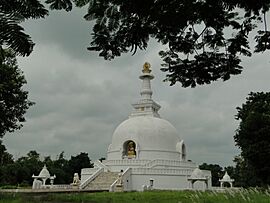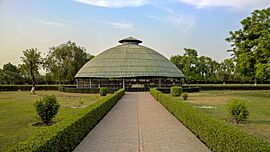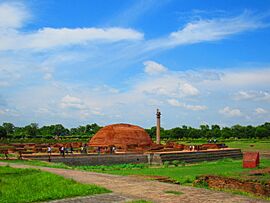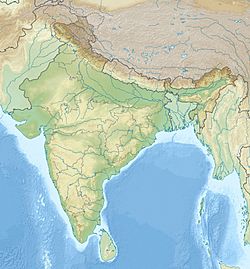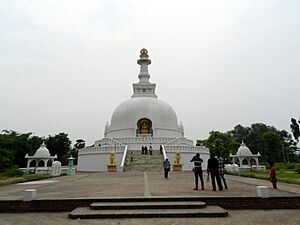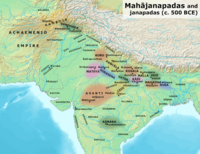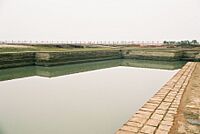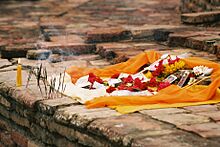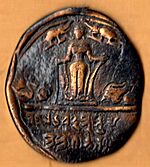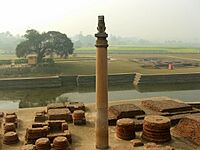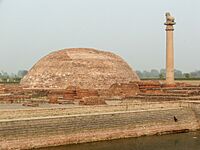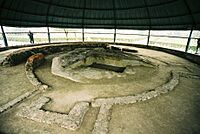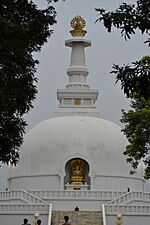Vaishali (ancient city) facts for kids
Quick facts for kids
Vaishali
Vaiśālī
Licchavi
|
|
|---|---|
|
Buddha Stupa, Relic Stupa, Ashok Pillar
|
|
| Country | |
| State | Bihar |
| Region | Mithila |
| District | Vaishali |
| Established | 599 BCE |
| Time zone | UTC+5:30 (IST) |
Vaishali, also known as Vesali or Vaiśālī, was an important ancient city in what is now Bihar, India. Today, it is an archaeological site, meaning a place where old ruins and artifacts are found. It is part of the Tirhut Division.
Vaishali was the capital city of the Vajjika League, a group of states known as the Vajji mahajanapada. This league was one of the world's first republics, formed around 600 BCE. A republic is a type of government where citizens elect leaders to represent them.
This city is very important for both Jain and Buddhist religions. Gautama Buddha gave his last sermon here before he passed away around 483 BCE. Later, in 383 BCE, the Second Buddhist council was held here by King Kalasoka. Vaishali also has one of the best-preserved Pillars of Ashoka, which is a tall stone pillar with a single Asiatic lion statue on top.
You can also find what might be the oldest known example of a stupa in Vaishali. A stupa is a dome-shaped building used as a place of meditation or to hold sacred relics. This one is called the Buddha relic stupa and is believed to contain some of the Buddha's ashes.
Chinese explorers like Faxian (in the 4th century CE) and Xuanzang (in the 7th century CE) wrote about Vaishali in their travel journals. These writings helped a British archaeologist named Alexander Cunningham identify the ancient city with the modern village of Basarh in Vaishali District, Bihar, in 1861.
Contents
What's in a Name? The Meaning of Vaishali
Vaishali gets its name from King Vishal. He was a famous king from the time of the Mahabharata, an ancient Indian epic.
A Look Back: Vaishali's Rich History
Even before Buddhism and Jainism became popular, Vaishali was the capital of the Licchavi state. This state was a republic. At that time, Vaishali was a large, important city. It was the capital of the Vaishali state, which covered much of the Gangetic region in what is now Bihar, India.
We don't know much about Vaishali's very early history. However, an ancient text called the Vishnu Purana lists 34 kings who ruled Vaishali. The first king was Nabhaga. He is said to have given up his throne because he believed in human rights. He supposedly said, "I am now a free tiller of the soil, king over my acre." The last of these 34 kings was Sumati, who lived around the same time as Dasaratha, the father of the Hindu god, Lord Rama.
Vaishali is also famous as the home of Amrapali. She was an Indian woman who appears in many folktales and Buddhist literature. Amrapali later became a follower of Buddha. Manudev, a famous king from the Lichchavi clan, wanted to marry Amrapali after seeing her dance in Vaishali.
About a kilometer away from the main site is Abhishek Pushkarini. This is a special tank where the elected leaders of Vaishali were traditionally anointed with sacred water. Near this tank, you can find a Japanese temple and the Vishwa Shanti Stupa, also known as the World Peace Pagoda. This stupa was built by the Nipponzan Myohoji group from Japan. A small part of the Buddha's relics found in Vaishali are placed inside the foundation and the top part of this stupa.
Next to the coronation tank is Stupa 1, also called the Relic Stupa. Here, the Lichchavis carefully placed one of the eight parts of the Buddha's relics. They received these relics after the Buddha passed away. After his last talk, the Buddha started his journey to Kushinagar. But the Licchavi people kept following him. The Buddha gave them his alms bowl, but they still didn't want to go back. So, the Buddha made it seem like a river was flooding, which made them turn around. This place might be Deora in the modern Kesariya village, where Ashoka later built another stupa. Ānanda, the Buddha's personal helper, also reached Nirvana (a state of perfect peace) in the middle of the Ganges River, outside Vaishali.
When Xuanzang visited Vaishali in the early 7th century, the city was not as grand as it used to be. He wrote that "the capital is ruined" and that it was more like a village or town than a big city.
Buddha's Visits to Vaishali
Vaishali is well known for its strong connection to the Buddha. When Prince Siddhartha (who later became the Buddha) left his home to seek enlightenment, he first came to Vaishali. Here, he received his early spiritual training from teachers like Uddaka Rāmaputta and Āḷāra Kālāma.
After he became the Buddha, he visited Vaishali many times. He even organized the Buddhist community, called the sangha, to be like Vaishali's democratic system. It was also in Vaishali that he first allowed women to join the sangha. His own maternal aunt, Mahaprajapati Gautami, was one of the first women to join.
The Buddha spent his last rainy season retreat (called Varshavasa) here. He announced that he would soon reach Mahaparinirvana (his final departure from the world) just three months before it happened. Before leaving for Kusinagara, where he passed away, he left his alms-bowl (Bhiksha-Patra) with the people of Vaishali.
Jainism's Connection to Vaishali
Followers of the Śvetāmbara branch of Jainism believe that the last Tirthankara, Lord Mahavira, was born and grew up in the Kshatriyakund district of Vaishali. His parents were King Siddhartha and Queen Trishala.
According to the Jain text Uttarapurāṇa, King Chetaka ruled Vaishali as a Republican President. He was a famous and kind king and a strong follower of Jainism. The text says that Chetaka had ten sons and seven daughters. His sister, Priyakarini (also known as Trishala), married Siddhartha. His daughter Chellana married Shrenik (also known as Bimbisara). The scholar Hermann Jacobi also states that Vardhaman Mahavira's mother Trishala was King Chetaka's sister.
Vaishali was also home to other important Jain figures like Kandaramasuka and Pātikaputta.
Important Buddhist Places in Vaishali
The Relic Stupa: Holding Buddha's Ashes
Near the coronation tank is Stupa 1, also known as the Relic Stupa. Here, the Licchavi people respectfully placed one of the eight parts of the Buddha's relics. They received these after the Buddha passed away. After his final talk, the Buddha began his journey to Kushinagar. However, the Licchavis kept following him. The Buddha gave them his alms bowl, but they still refused to go back. He then created an illusion of a river that was flooding, which made them return. This place might be Deora in the modern Kesariya village, where Ashoka later built a stupa.
Recent studies suggest that this relic stupa could be one of the earliest stupas ever found by archaeologists.
Kutagarasala Vihara: Buddha's Favorite Monastery
Kutagarasala Vihara was the monastery where the Buddha stayed most often when he visited Vaishali. It is about 3 kilometers from the Relic Stupa. On its grounds, you can find the Ānanda Stupa and a very well-preserved Asokan pillar. This might be the only complete Asokan pillar still standing today. There is also an ancient pond nearby.
Coronation Tank: Where Leaders Were Chosen
A few hundred metres from the Relic Stupa is Abhishek Pushkarini, the coronation tank. The sacred water from this tank was used to anoint the elected leaders of Vaishali during their ceremonies.
World Peace Pagoda: A Symbol of Peace
Next to the coronation tank, you'll see a Japanese temple and the Viśvā Śānti Stūpa, also known as the World Peace Pagoda. This was built by the Japanese Nichiren Buddhist group Nipponzan-Myōhōji. A small part of the Buddha's relics found in Vaishali are placed inside the foundation and the top part of this stupa.
The Vaishali Museum was opened in 1971 by the Archaeological Survey of India. Its purpose is to protect and show the old objects found during digs around ancient Vaishali.
Recent Developments in Vaishali
- In February 2019, Nitish Kumar, the Chief Minister of Bihar, started the building of the Buddha Samyak Darshan Museum and Memorial Stupa. This museum will house Buddha relics.
- In September 2020, Narendra Modi, the Prime Minister of India, opened the Vaishali Railway station. This new train line now connects Vaishali with Hajipur and Patna.
Famous People from Vaishali's Past
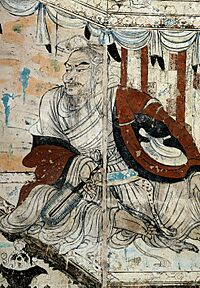
- Mahavira: He was the 24th Tirthankara of Jainism. He was born into a royal family in what is now the Vaishali district of Bihar. At age 30, he gave up all his worldly possessions to become an ascetic, someone who lives a simple life without luxuries. He lived around the same time as the Buddha.
- Chetaka: He was a King and ruler of the Vajjika League, which had its capital in Vaishali.
- Vimalakirti: He is a main character in the Vimalakirti Sutra, an important Buddhist text. He was a lay practitioner of Buddhism, meaning he followed Buddhist teachings but was not a monk.
See also
- Mithila (region)
- Pillars of Ashoka
- Chaumukhi Mahadev Mandir


